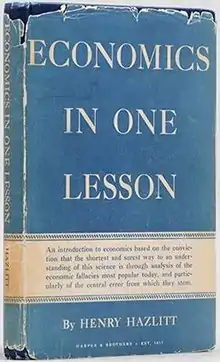Economics in One Lesson
Economics in One Lesson is an introduction to economics written by Henry Hazlitt and first published in 1946. It is based on Frédéric Bastiat's essay Ce qu'on voit et ce qu'on ne voit pas (English: "What is Seen and What is Not Seen").[1]
 First edition | |
| Author | Henry Hazlitt |
|---|---|
| Country | United States |
| Language | English |
| Subject | Economics |
| Publisher | Harper & Brothers |
Publication date | 1946 |
| Pages | 218 |
| ISBN | 0517548232 |
| OCLC | 167574 |
The "One Lesson" is stated in Part One of the book:
The art of economics consists in looking not merely at the immediate but at the longer effects of any act or policy; it consists in tracing the consequences of that policy not merely for one group but for all groups.
Part Two consists of twenty-four chapters, each demonstrating the lesson by tracing the effects of one common economic belief, and exposing common economic belief as a series of fallacies.
Among its policy recommendations are the advocacy of free trade, an opposition to price controls, an opposition to monetary inflation, and an opposition to stimulative governmental expenditures:
There are men regarded today as brilliant economists, who deprecate saving and recommend squandering on a national scale as the way of economic salvation; and when anyone points to what the consequences of these policies will be in the long run, they reply flippantly, as might the prodigal son of a warning father: 'In the long run we are all dead.' And such shallow wisecracks pass as devastating epigrams and the ripest wisdom.
Criticism
Economist J. Bradford DeLong said Hazlitt's book well states the Classical view of economics, but does not properly address arguments made by Keynesians.[2] However, in 1959 Hazlitt published The Failure of the New Economics, a detailed, chapter-by-chapter critique of John Maynard Keynes' arguments.
Publication history
In a paperback edition in 1961, a new chapter was added on rent control, which had not been specifically considered in the first edition apart from government price-fixing in general. A few statistics and illustrative references were brought up to date.
In 1978, a new edition was released. In addition to bringing all illustrations and statistics up to date, an entirely new chapter on rent control replaced the previous one of 1961, and a final new chapter, "The Lesson After Thirty Years," was added.
The book has been translated into many other languages, such as Spanish, German, Russian, Chinese, Korean and Greek.[3] In particular, the Madrid-based Spanish publishing house Unión Editorial, which traditionally publishes books in Spanish language in defense of market economy and liberalism, released La Economía en una lección in 1981, 1996 and 2005. A German edition, titled Economics. Über Wirtschaft und Misswirtschaft, was first released in 1983 by Poller in Stuttgart. In May 2009, it was reprinted by Olzog.
Bibliography
- Economics in One Lesson. Special Edition for the Foundation for Economic Education. New York: Pocket Books. 1952.CS1 maint: others (link)
- Economics in One Lesson. New York: Three Rivers Press. 1988. ISBN 978-0517548233.
- Economics in One Lesson: 50th Anniversary Edition. Fox & Wilkes. 1996. ISBN 0930073193. ISBN 0930073207 (hardback)
- Economics in One Lesson. Introduction by Walter Block. Auburn: Ludwig von Mises Institute. 2008. ISBN 978-1933550213.CS1 maint: others (link)
- Economics in One Lesson. Baltimore: LFB. 2012. ISBN 978-0983541462.
References
- Called Hazlitt's "most enduring contribution," the book has sold nearly one million copies and is available in at least ten languages. See: "Economics in One Lesson, The Shortest and Surest Way to Understand Basic Economics". Random House.com. Retrieved 2011-02-16.; "Economics in One Lesson, 50th Anniversary Edition". Voice For Liberty in Wichita. 1933-10-16. Retrieved 2011-02-16.
- DeLong, Brad (April 10, 2005). "Economics in One Lesson". Brad DeLong – Grasping Reality with Both Invisible Hands: Fair, Balanced, and Reality-Based: A Semi-Daily Journal. Brad DeLong.
- https://www.atlasnetwork.org/news/article/greek-translation-of-economics-in-one-lesson-sells-out-every-copy-in-two-mo
